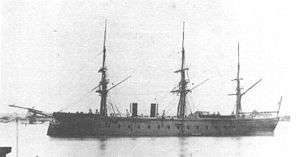Spanish ironclad Sagunto
The Spanish ironclad Sagunto was a wooden-hulled armored frigate built for the Royal Spanish Navy (Armada Real) in the 1860s and 1870s. She was originally built as a large ship of the line, but was converted into a central-battery ironclad while still under construction. She was stricken from the naval register in 1891.
 Sagunto at anchor | |
| History | |
|---|---|
| Name: | Sagunto |
| Namesake: | Siege of Saguntum |
| Ordered: | December 1862 |
| Builder: | Reales Astilleros de Esteiro, Ferrol |
| Laid down: | 21 March 1863 |
| Launched: | 26 April 1869 |
| Completed: | 1 February 1877 |
| Commissioned: | February 1877 |
| Renamed: | Sagunto, 1868 |
| Stricken: | 1891 |
| General characteristics | |
| Type: | Central-battery ironclad |
| Displacement: | 7,352 t (7,236 long tons) |
| Length: | 89.5 m (293 ft 8 in) (waterline) |
| Beam: | 17.3 m (56 ft 9 in) |
| Draft: | 8.4 m (28 ft) |
| Installed power: | |
| Propulsion: | 1 shaft, 2 compound-expansion steam engines |
| Sail plan: | Ship rig |
| Speed: | 12.5 knots (23.2 km/h; 14.4 mph) |
| Complement: | 554 |
| Armament: |
|
| Armor: | |
Design and description
.jpg)
Segunto was 89.5 meters (293 ft 8 in) long at the waterline, had a beam of 17.3 meters (56 ft 9 in) and a draft of 8.4 meters (27 ft 7 in).[1] She displaced 7,352 metric tons (7,236 long tons) and was fitted with a ram bow.[2] Her crew consisted of 554 officers and enlisted men.[1]
The ship was fitted with a pair of imported Forges et Chantiers de la Méditerranée compound-expansion steam engines that drove one propeller shaft using steam provided by eight cylindrical boilers. The engines were rated at a total of 1,000 nominal horsepower or 3,700 indicated horsepower (2,800 kW)[2] and gave Sagunto a speed of 12.5 knots (23.2 km/h; 14.4 mph)[1] The ironclad carried a maximum of 900 metric tons (886 long tons) of coal.[3] She was fitted with a three-masted ship rig with a sail area of 2,400 square meters (26,000 sq ft).[4]
The frigate's main battery was originally intended to consist of thirty 200-millimeter (7.9 in) smoothbore guns mounted on the broadside, but she was completed with eight single Armstrong-Whitworth 229-millimeter (9 in) rifled muzzle-loading (RML) guns on the main deck arranged on the central-battery principle. On the upper deck were two Trubia 180-millimeter (7.1 in) RML guns, one on each broadside, and another in the forecastle as the forward chase gun. By 1883, the Trubia guns had been replaced by Palliser RMLs of the same caliber.[5]
Sagunto had a complete wrought iron waterline belt of 150-millimeter (5.9 in) armor plates. Above the belt, the guns, except for the chase gun, were protected by an equal thickness of armor. The ends of the ship and the deck were unarmored.[6]
Construction and service
Segunto, named for the ancient Siege of Saguntum,[7] was ordered in December 1862 as the 100-gun ship of the line Principe Don Alfonso from the Royal Shipyard of Esteiro (Reales Astilleros de Esteiro) in Ferrol.[1] The ship was laid down on 21 March 1863 and she was renamed Segunto in 1868 while she was being converted into a central-battery ironclad. The ship was launched on 26 April 1869 and commissioned on 1 February 1877.[7]
Footnotes
- de Saint Humber, p. 23
- Silverstone, p. 389
- Lyon, p. 381
- de Saint Hubert, pp. 22, 24
- de Saint Hubert, p. 28
- de Saint Hubert, pp. 22–23
- Silverstone, p. 395
References
- Brassey, Thomas (1888). The Naval Annual 1887. Portsmouth, England: J. Griffin. OCLC 669097244.
- de Saint Hubert, Christian (1984). "Early Spanish Steam Warships, Part II". Warship International. XXI (1): 21–45. ISSN 0043-0374.
- Lyon, Hugh (1979). "Spain". In Chesneau, Roger & Kolesnik, Eugene M. (eds.). Conway's All the World's Fighting Ships 1860–1905. Greenwich, UK: Conway Maritime Press. pp. 380–386. ISBN 0-8317-0302-4.
- Silverstone, Paul H. (1984). Directory of the World's Capital Ships. New York: Hippocrene Books. ISBN 0-88254-979-0.